Let's face it: link-building is complex. From the choice of metrics to track to the selection of link-building strategies or link prospects, there are lots of things to take care of.
And lots of things that you can potentially forget about, even as an experienced link-builder.
To help you avoid this, we've compiled a comprehensive link-building checklist.
In the article, you will learn about each of the included link-building activities, why they're important and how to conduct them.
Key takeaways
- Conduct a thorough backlink audit to assess your current link profile and identify areas for improvement.
- Analyze competitor backlinks to uncover successful strategies and new link opportunities.
- Set SMART goals for your link-building campaign to focus your efforts and measure success.
- Choose target pages strategically, considering your goals and the potential for organic traffic growth.
- Estimate the number of backlinks needed to rank for your target keywords using competitor data.
- Reclaim broken links and fix internal broken links.
- Claim unlinked brand mentions to quickly strengthen your backlink profile.
- Find guest posting opportunities using Google search operators and competitor backlink analysis.
- Identify pages for link insertions, focusing on listicles and resource pages.
- Evaluate potential link partners based on relevance, domain metrics, organic traffic, anchor text, and overall link profile.
- Avoid link farms by checking for thin content and using Link Classifier tools.
- Create high-quality, linkable content that fulfills search intent, offers unique insights, and is optimized for search.
- When guest posting, analyze the website target audience and follow guidelines.
- Verify that acquired links are dofollow for maximum link equity transfer.
- Link attributes (nofollow, sponsored, or UGC tags) may impact the link's value but you can’t always avoid them.
- Ensure linked pages are indexable by search engines. Otherwise, they won’t benefit your SEO performance.
- If you’d like help with your link-building efforts, get in touch with the Editorial.Link team.
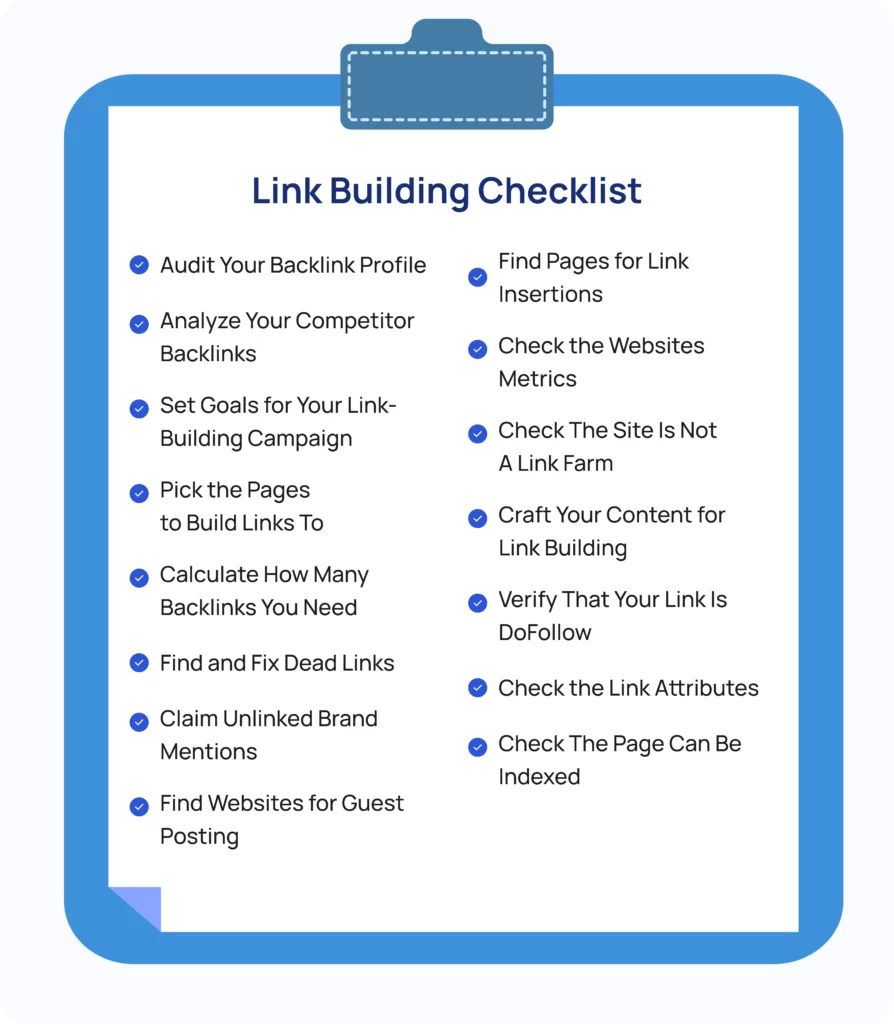
1. Audit Your Backlink Profile
Before you start building links, conduct a backlink profile audit to understand its strengths and weaknesses. Insights from a thorough audit will help you make informed decisions and guide your link-building efforts. And will act as a baseline to measure progress against.
Here’s how to do it:
1. Check your key metrics. This includes your DR/DA, backlink count, and referring domain count. You can find all these in the Backlinks report in Ahrefs.
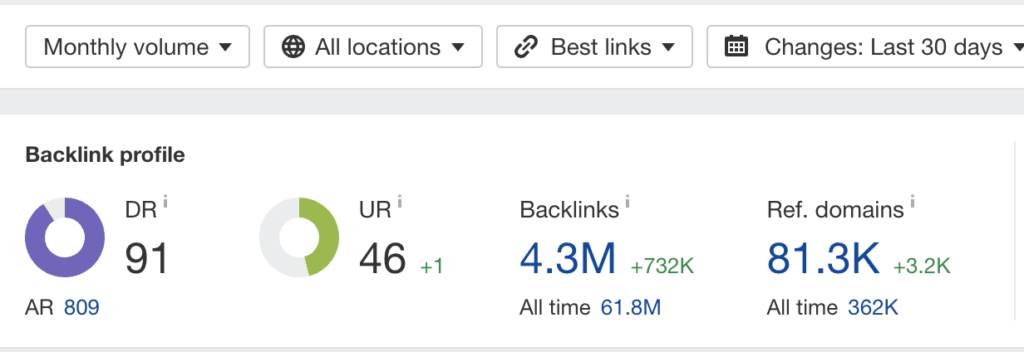
2. Check if the backlink DR distribution and the dofollow/nofollow ratio are natural.
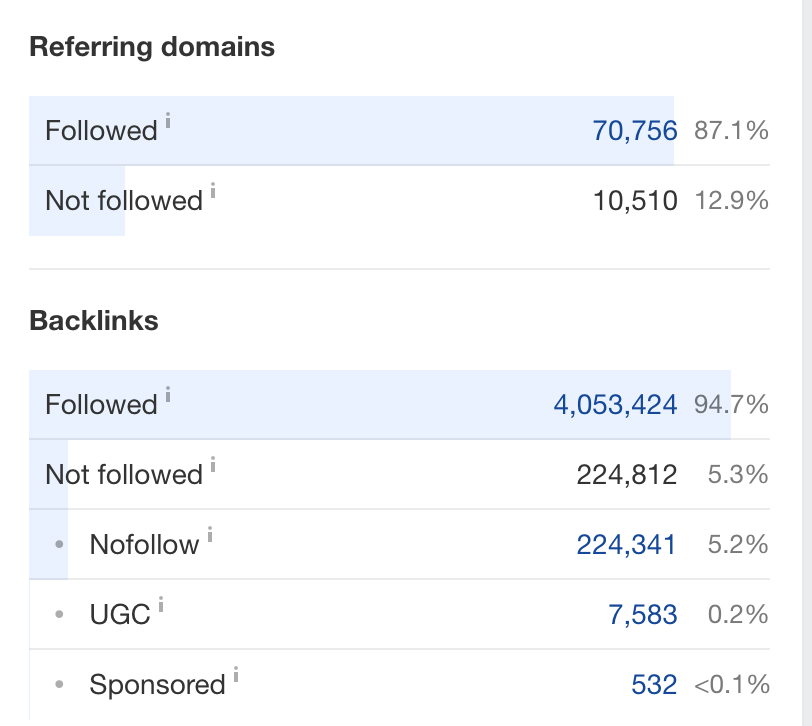
3. Assess the historical backlink acquisition trend for unnatural patterns.
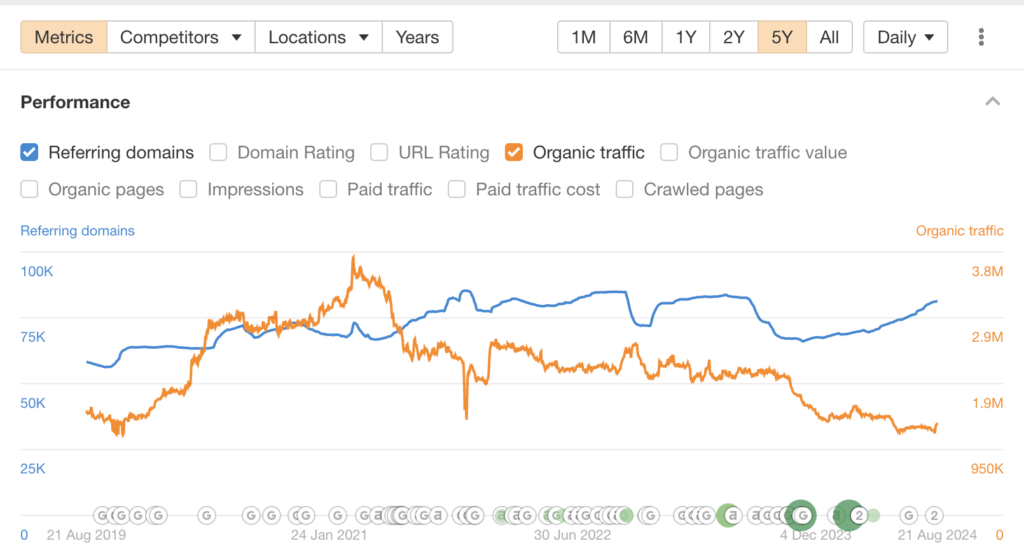
4. Look for unnatural and over-optimized anchor texts. Or dodgy ones, like ‘casinos.’
5. If you’re at risk of manual penalties or you know your predecessor was involved in black-hat practices, disavow spammy links. They may be hurting your SERP performance.

2. Analyze Your Competitor Backlinks
By analyzing your competitor's backlinks, you can understand which strategies they use, what kind of content attracts the most links, and find new link opportunities.
Who are your competitors? If you’re not sure, you can find it out from the Organic competitors report in Site Explorer in Ahrefs (Semrush also has the Organic Competitors feature).

Next, use the Competitive Analysis tool (report on Link Intersect has been replaced with a new one located in the Competitive Analysis tool) to look for pages that link to your competitors but not you.

Dive deeper and X-ray individual competitor sites using the Site Explorer.
- In the Backlinks report, check their DR, the number of links and referring domains, and link acquisition history. This will help you understand how actively they’re building links.
- In the Best by links report, analyze the types of links in their profile. That’s how you will find the most successful link-building strategies and linkable assets.
For example, below, you can see that articles with statistics have worked very well for one of our competitors. We could replicate their success by producing similar content (and we did).
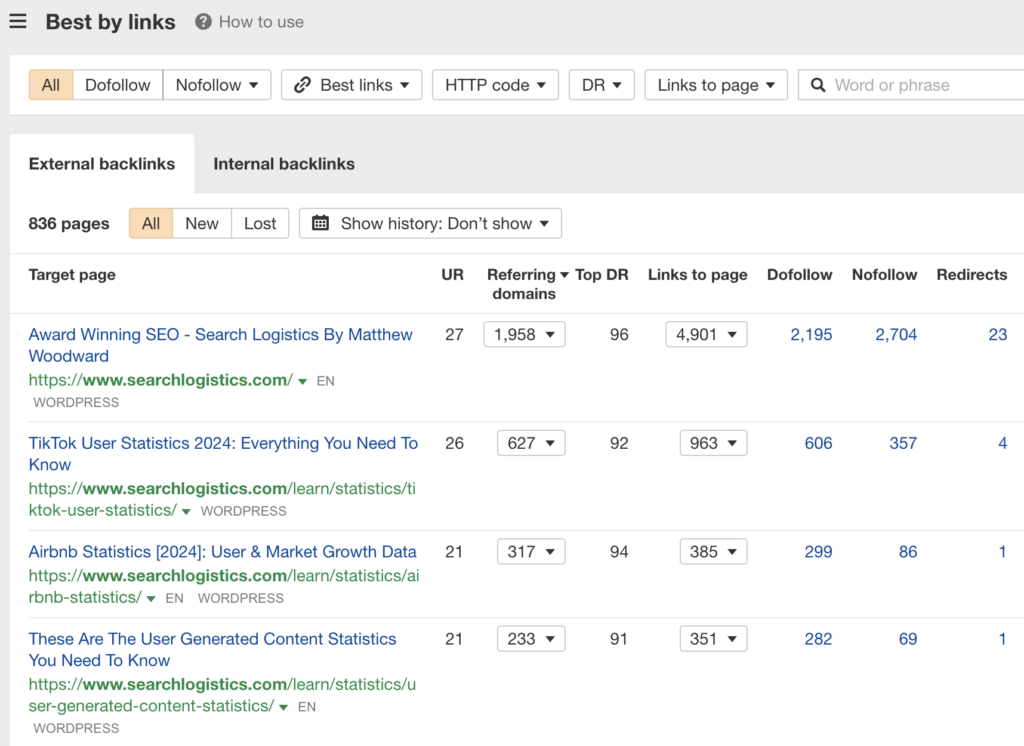
3. Set Goals for Your Link-Building Campaign
Remember: link-building is only a means to an end. So, to give your link-building campaign focus, define your objectives.
Are you looking to grow revenue? Boost organic traffic? Increase your brand visibility and establish subject authority?
The answer to the question will determine the choice of tactics and the resources you need to invest.
For example, if your goal is increasing visibility, appearing in podcasts and interviews and collaborating with influencers will bring better results than, say, broken link building.
Make sure your goals are measurable and specific. Use a framework like SMART (Specific, Measurable, Achievable, Relevant, Time-bound).
For instance, if you want to boost your traffic, the goal could be to ‘Improve organic traffic by 3.5% by the end of Q3.’
4. Pick the Pages to Build Links To
Choosing the wrong pages to build links to can easily burn your budget.
To some extent, the choice of target pages depends on your goal.
Let me explain:
Imagine that your goal is increasing conversions, for example, free-trial sign-ups. The logical conclusion would be to build links to your landing pages.
Such backlinks, however, may be more difficult to build because they’re harder to embed naturally in the text.
The alternative approach that we recommend is building links to informational content related to the product use case, optimizing it for conversions, and using internal linking to pass the link juice to the commercial pages.
If you go this way, pick pages that are already getting organic traffic and ideally ranking or ones targeting low-difficulty keywords, which won’t require dozens of links to rank for.
You can find such pages in the Top pages report by filtering the results by their position and traffic.
Here’s the report showing pages with 100+ traffic in positions 5-20.

5. Calculate How Many Backlinks You Need
‘How many backlinks do I need to rank?’ is one of the most frequently asked SEO questions.
Unfortunately, there’s no simple answer, as it depends on the keyword difficulty. For competitive target keywords like ‘link-building,’ you’d need hundreds of high-quality backlinks to rank.
You can find it out from the Keywords Explorer in Ahrefs.
In this particular instance, it’s around 756 links from unique referring domains.
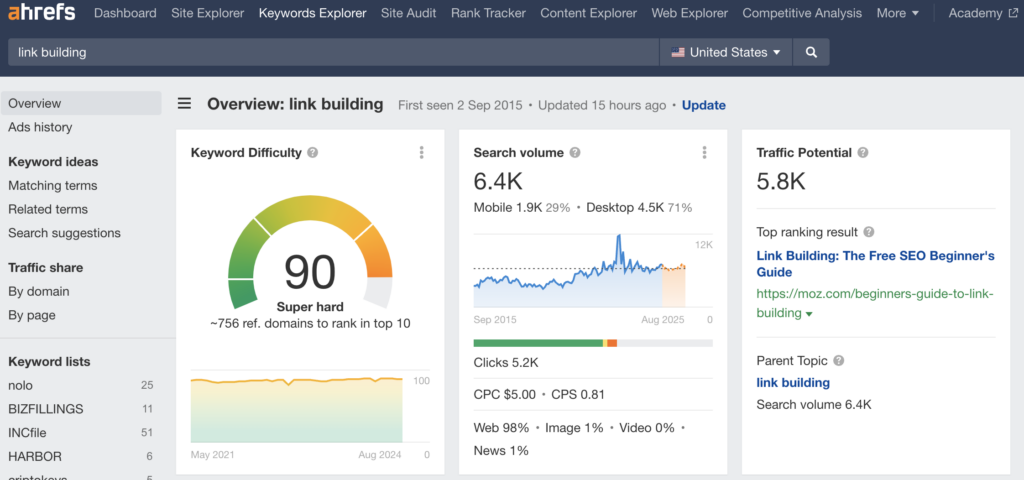
Mind you, though, that not all the top-performing blogs ranking for the keyword have that many links.
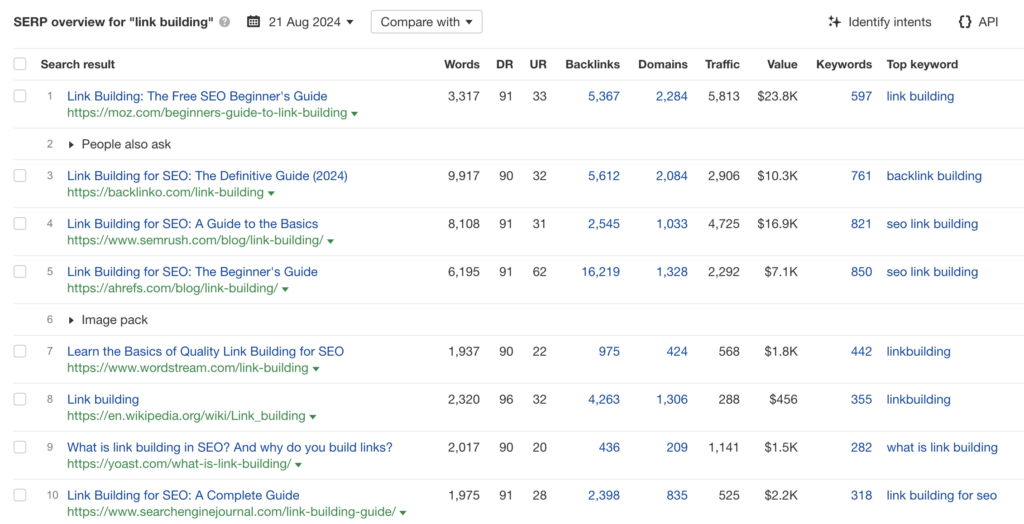
Here’s how we estimate the number of links needed to rank:
In the competitor’s backlinks report, filter the data by DR35+, traffic 1000+, and dofollow.
The Moz article, currently in the #1 spot for ‘link building,’ has 2284 referring domains.
However, after filtering the results, we get 373. That’s more manageable but still a big ask, and you need to have the right resources to take it on.

6. Find and Fix Dead Links
The benefits of Increasing your link juice supply will be limited if your bucket leaks. So before you build new links, check your profile for broken links and reclaim them.
All major SEO suites have tools for finding broken links pointing to your site. In Ahrefs, it’s called… surprise, surprise… Broken backlinks.
Using the same filters as before (DR35+, traffic 1000+, dofollow), filter the pages with broken links to help you prioritize your efforts.
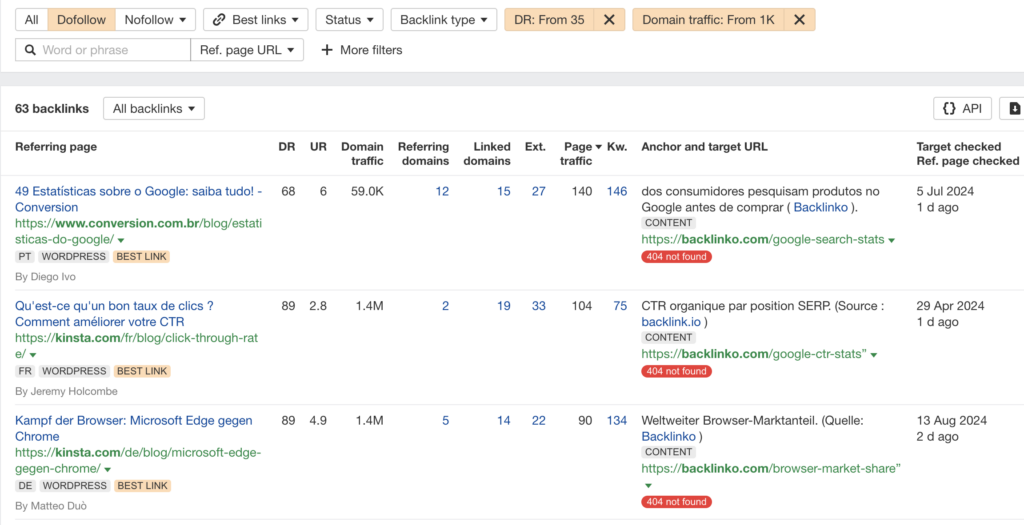
All that is left is to contact the website owners or backlink vendors and ask them to reinstate the links.
This tactic can also be used to steal your competitors’ broken links.
And one final point: make sure to fix all internal backlinks on your website.
Broken internal links make it difficult for search engines to understand your site structure and negatively affect user experience, which is a ranking factor.
7. Claim Unlinked Brand Mentions
Claiming unlinked brand mentions is another relatively easy way to strengthen your backlink profile. Getting links from sites that already talk about your brand is easier because they don’t need persuading to include you in their content. You just need to ask them for the link.
Here’s how to find them with Ahrefs Content Explorer:
1. Search for your brand, product, company tagline, or company leaders (in Content). Exclude your site from the search using the -site: operator. For example, “editorial.link” -site:editorial.link

2. In Highlight unlinked, add your domain name.

3. Filter the prospect list (DR30-70, Traffic>500, Page traffic >50)

4. Export the results.
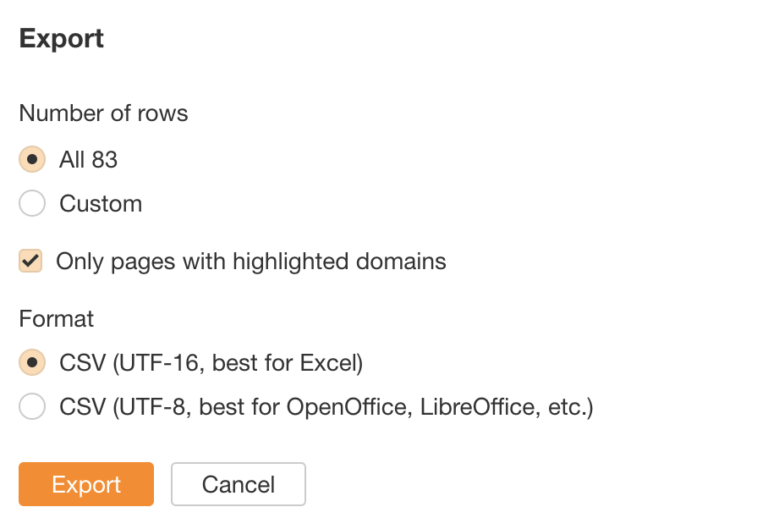
Next, reach out to the site owners with personalized emails.
As mentioned, the method is perhaps easier than others but usually not entirely free. Most SEOs and website owners know how valuable backlinks are and expect something in exchange.
8. Find Websites for Guest Posting
Guest posting was the second most popular link-building method, according to the SEO experts who took part in our State of Link-Building study.
Each guest post can get you 4-5 backlinks even if you’re allowed to link to your page once only. That’s because you often get a chance to your partner’s sites, who then reciprocate by linking to yours from their guest posts.
It also allows you to reach new audiences, increasing your brand exposure.
The easiest way to find guest posting opportunities is with Google search operators. Simply search for your keyword + “write for us” or one of the terms below.
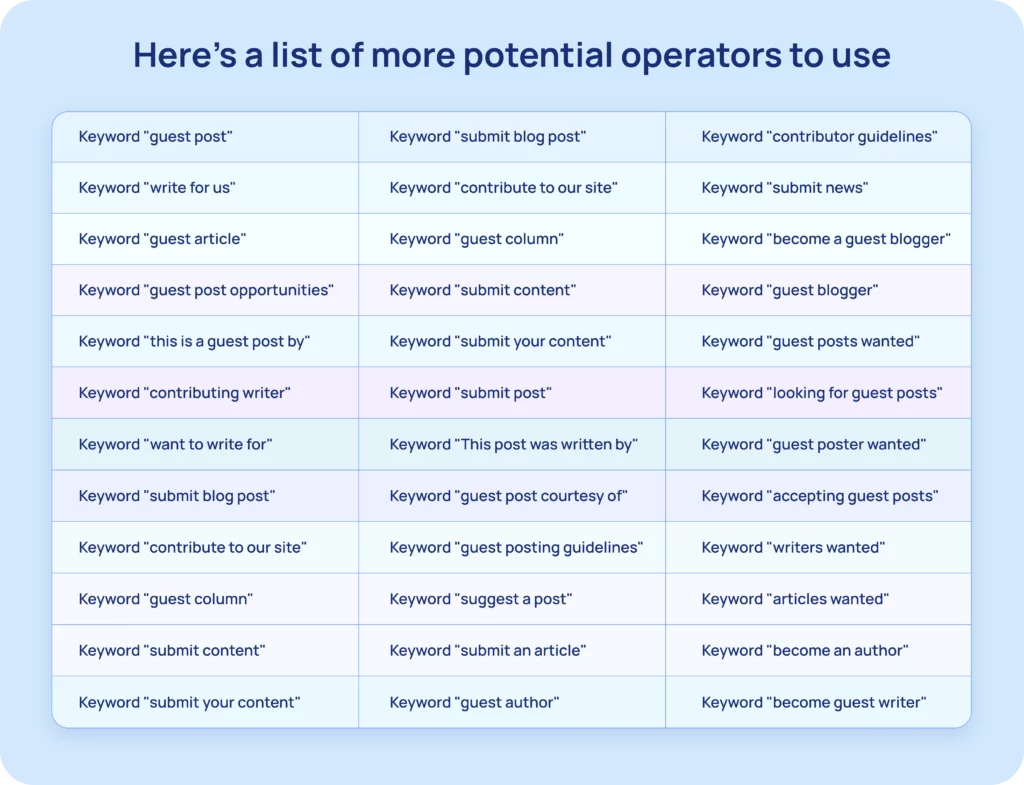
You can also find them by analyzing your competitors' backlinks.
In the Backlinks report, filter their results by those that contain the term ‘blog’ to narrow down the selection and then eyeball the results for guest posts.

Or use the Content Explorer and search for the posts written by renown bloggers in your niche. In the search bar, enter topic + author:”name”. For instance, link building + author:"Neil Patel"
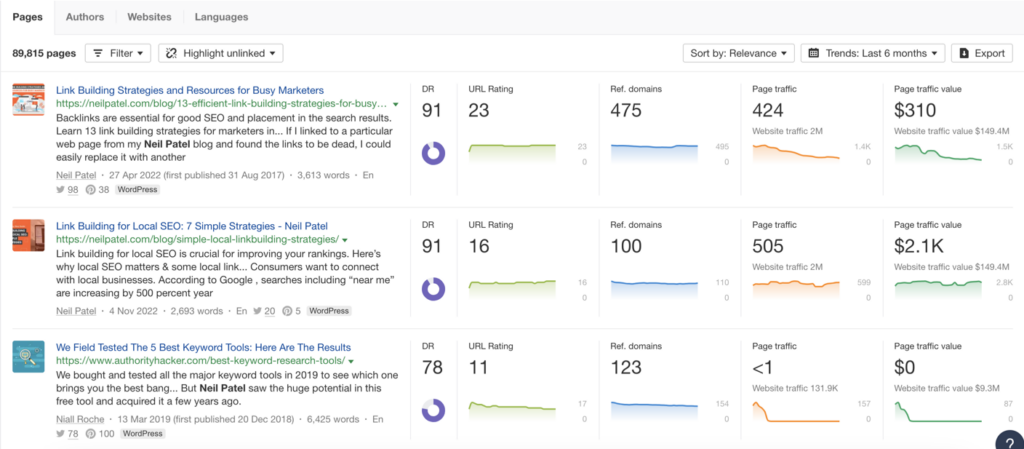
10. Find Pages for Link Insertions
Link insertions, or niche edits, are another popular tactic because you don’t have to produce much content. An article section, at most.
Another benefit is that you get a link from a page that already ranks and has traffic.
How do you look for such opportunities?
Listicles featuring your competitors but not you are a good start.
You can find them with Content Explorer by typing “competitor A” “competitor B” “competitor C” -”your company name”. For example, “asana” “wrike” “clickup” “ms project” -”trello”.
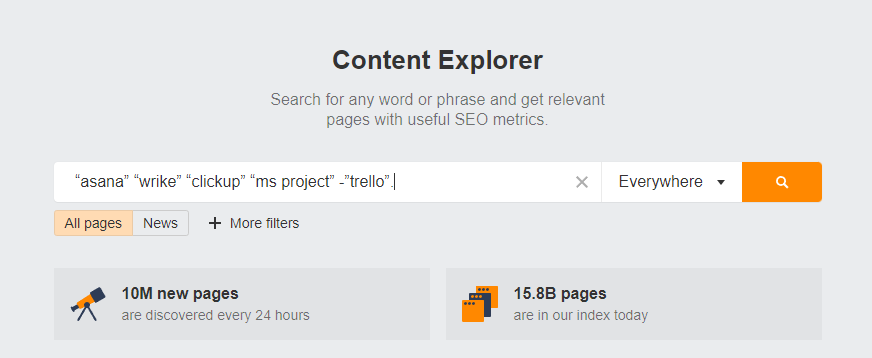
The ideal targets are pages with high traffic, so use filters to narrow down the prospect page.

Resource pages are another excellent source.
To find them, use Google operators:
- keyword intitle:resources inurl:resources.html
- keyword intitle:resources inurl:links.html
- keyword intitle:links inurl: resources.html
- keyword inurl:.com/resources
- keyword inurl:resources intitle:resources

11. Check the Websites Metrics
Let’s be realistic: Nobody has the resources to target all prospective websites you might have identified. And even if you had, it wouldn’t be recommended as links from some can harm your search engine rankings more than help them.
Here are the six metrics and qualities I check when assessing prospective link partners.
Relevance
Relevance is one of the main Google ranking factors.
This was reflected in the responses we got from the experts who took part in our study: 84.6% of them found relevance the most important criterion.
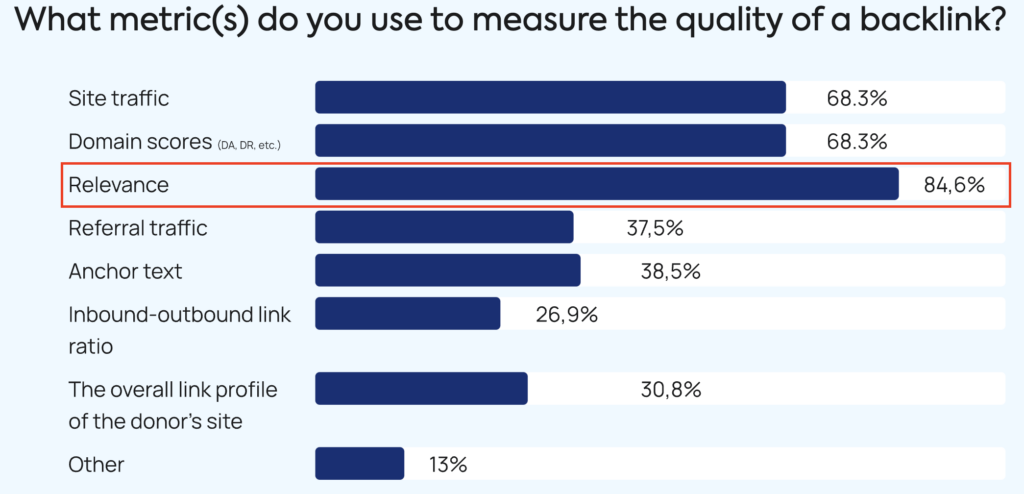
What makes a backlink relevant?
Consider these:
- Topical relevance: Does the page cover the same topic as yours?
- Geographical relevance: Does the page refer to the same location as yours? For example, a link from a New York City guide isn’t relevant to a page about Poland.
- Temporal relevance: Is the page content linked to the same time period as yours? For example, if you run a campsite booking page, you don’t want links from an article with tips on how to spend the Christmas holidays.
- Semantic relevance: Do the meaning and context of the linking content match the target page?
- Target audience alignment: Does the link content appeal to the same audience as your page?
Check domain scores
Metrics like Domain Rating, Domain Authority, or Authority Score give you a quick glimpse of the page quality.
SEOs we interviewed for our State of Link-Building Report find them fairly reliable when it comes to determining the prospect website authority.
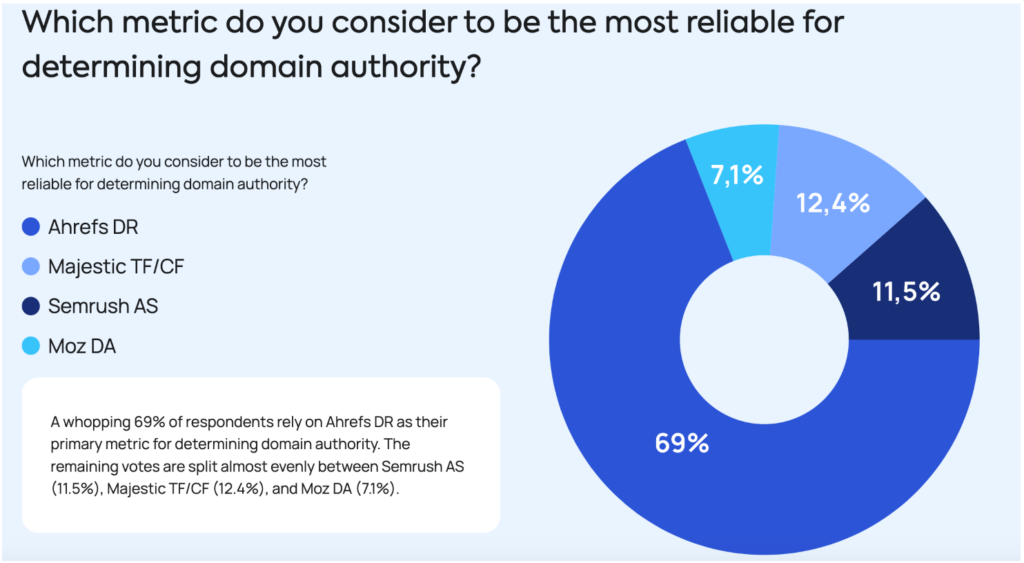
Use them with caution, though. They’re fairly easy to manipulate, for example, by buying cheap links, so always consider them in the context of other metrics, like traffic or the inbound/outbound link ratio.
Check organic traffic
Organic traffic matters for two reasons.
First, it tells you about the quality of the content. If a site attracts lots of traffic, it’s safe to assume readers value it. If, on the other hand, a site has high DR and lots of links but no traffic, they’re up to no good (read: buying links).
Traffic also tells you how much referral traffic you can get through the link. Sites with big audiences can increase your brand exposure and help you reach readers you wouldn’t be able to otherwise.
To check traffic in Ahrefs, head to the Overview section in Site Explorer. Semrush offers the same insights in Domain Overview.

Check anchor text
As mentioned, by checking anchor texts, you can find spammy links pointing to a site. If a website links to gambling or adult content pages, give it a miss.
You can find it out by heading to the Anchors report in Ahrefs Site Explorer and searching anchors for terms like ‘Viagra,’ ‘casino,’ ‘pills,’ ‘dating,’ etc.

Check the inbound/outbound link ratio
There are two reasons why you want to check the incoming/outgoing link ratio.
For starters, the number of outbound links determines how much equity the link passes. The more of them, the more pages there are to feed, which reduces the benefits for your site.
More importantly, a site with an unnaturally high number of outbound links may be involved in shenanigans like selling links.
Ahrefs has a report in Site Explorer called Outgoing links, where you can find out how many domains the page links to.

To understand the ratio, just compare it to the referring domain count from the Overview.
For example, Semrush has around 350K outbound links to 7.6K domains and 10.4M inbound links from 113K domains.
I think it’s a safe one, I wouldn’t be afraid to accept a link from them. 😉
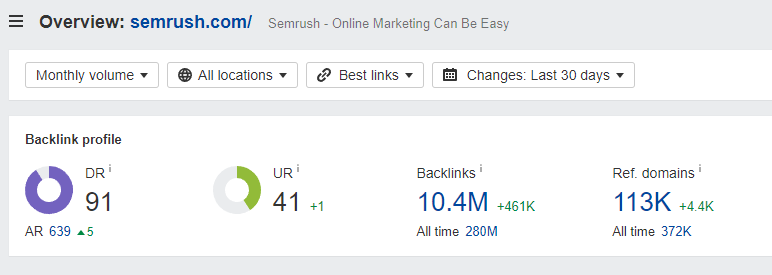
Check overall link profile
Just like you did with your site, have a quick look at their overall link profile.
Does it look healthy? Are they actively acquiring new high-quality links and enhancing their authority?
It’s a good idea to have a quick look at their website design and content as well. It can tell you a lot about the link quality.
12. Check the Site Is Not a Link Farm
Link farms are websites designed for one purpose only: to sell links.
Such links might be cheap but they’re low quality. Even if the website has a decent DR, it’s usually not relevant, has poor inbound/outbound link ratios, and no organic traffic.
Consequently, they aren’t likely to improve your SERP performance and, in some situations, can hurt it. That’s because they violate Google’s webmaster guidelines as schemes designed to manipulate rankings.
Even if they had any positive impact, such sites often disappear quickly, so the impact would be short-lived.
How can you identify if you’re dealing with a link farm?
Apart from the metrics, other signs include thin content on a wide range of topics. If one site links to pages in the SaaS, property, automotive, healthcare, and real estate industries, it’s probably a link farm.
You can also use our free Link Type Classifier to check it. Just enter the URLs to assess (up to 1000 of them) and hit Check My Links Now.
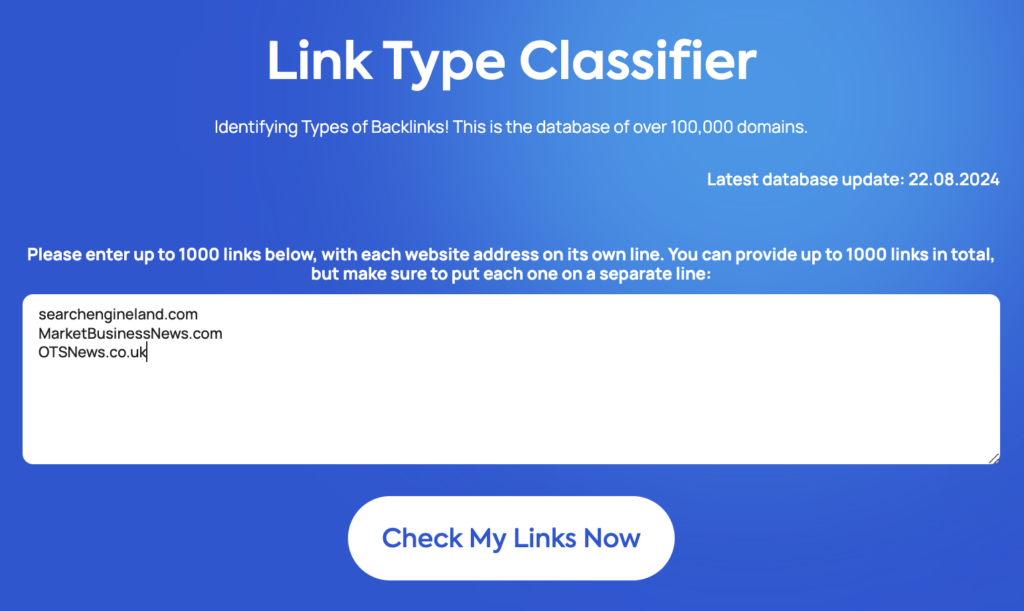
Here’s what the report looks like. The ‘red’ links are link farms.
Easy and effective.
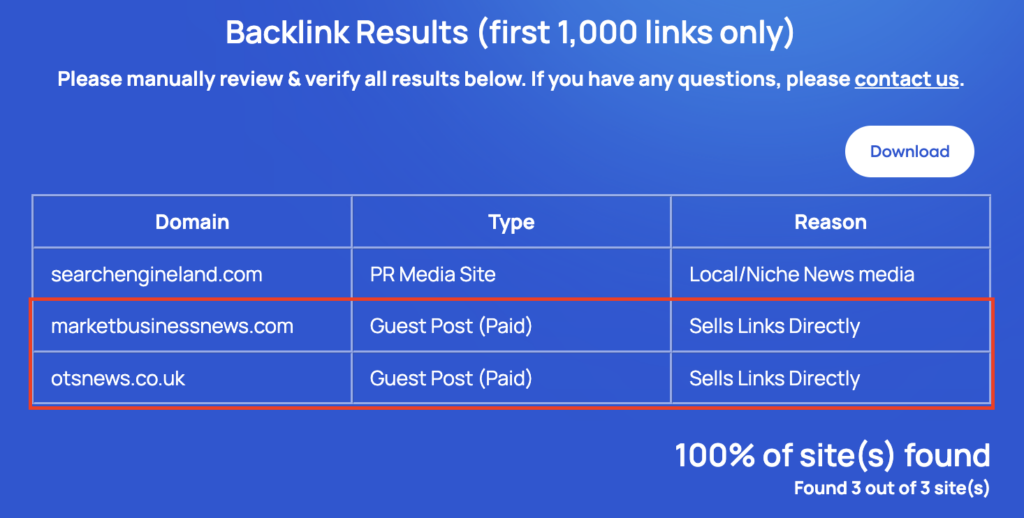
13. Craft Your Content for Link Building
Regardless of which link-building tactics you use, you’re more likely to score a hit if you create quality content. For example, your guest posts have a better chance of getting accepted and published if they’re well-crafted and offer unique insights.
So, how do you create such awesome content that naturally attracts links and opens doors to new link-building collaborations?
Here are a few tips:
- Fulfill the search intent to make it relevant to readers.
- Make it more comprehensive than others by covering more aspects of the problems.
- Offer a unique angle or insights, for example, by adding expert comments.
- Use up-to-date statistics, examples, and case studies, reference recent events and developments or the latest tools.
- Make the content visually appealing and engaging by adding visuals, like infographics, diagrams, and videos.
- Demonstrate your expertise by referring to your experience.
- Optimize it for SEO to make it easier to find.
When writing guest posts, always follow the website guidelines, such as regarding word count, punctuation, or links.
In addition to the format and style of the existing articles, research the audience, their interests, and potential content gaps. Ideally, do it before you even approach the website and use the insights to tailor your pitch.
14. Verify that Your Link Is DoFollow
When you acquire a new link, always check if it’s a dofollow one. Such links are more valuable than nofollow links because they pump more link juice.
Don’t get me wrong:
A nofollow link from a high-authority site, for example, a major news outlet, can offer lots of benefits. For example, it gets your content in front of thousands of readers. Sometimes, such websites don’t offer dofollow backlinks, so nofollow is all you’re getting.
However, in general, you should still prioritize dofollow backlinks, especially if you have to reward the ‘referring site’ for the favor.
15. Check the Link Attributes
Nofollow isn’t the only possible rel attribute that your link can have. The other ones include ‘sponsored’ and ‘ugc’.
The latter stands for User Generated Content. That’s how links from forums and blog post comments are marked. The impact of such links is negligible.
However, Google has recently been promoting big sites, including Reddit and Quora, so you may be able to get some exposure by promoting your brand there.
As to ‘sponsored’, that’s how Google wants webmasters to mark paid links. This tells it that you don’t necessarily vouch for the quality of the content, and it should treat the link cautiously when it decides how to rank the page.
Ideally, you don’t want such attributes attached to your links, but as with nofollow links, this may not be possible.
For example, on Search Engine Land, all links are sponsored. And yet, they’re totally worth it because of the visibility they bring to your brand and the referral traffic they send your way.
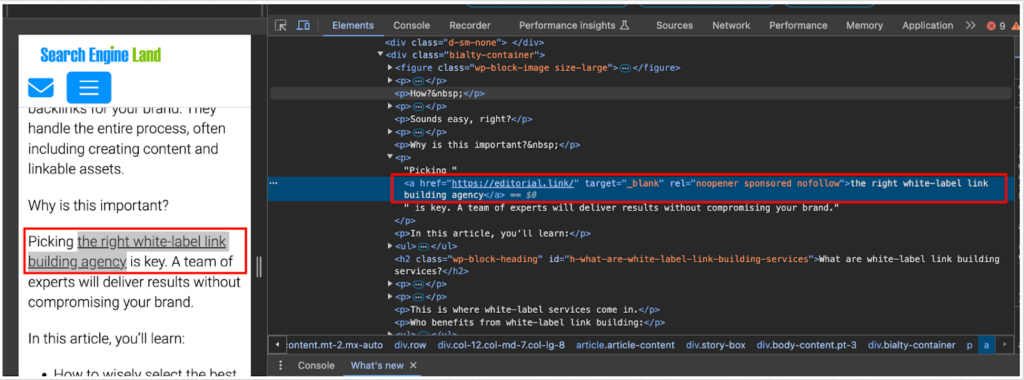
16. Check The Page Can Be Indexed
For a link to benefit your SEO performance, it needs to be indexed by search engines.
Or at least indexable. The latter means that it might not be in the index now, but there’s nothing that stops it from being crawled and indexed.
A link may not be indexable because of technical issues or low-quality content. Or the website owner may have blocked crawlers intentionally by disabling them in the robots.txt file or by adding the ‘noindex’ meta tag.
To quickly check if a page is indexed, you can use the site: search operator + the URL, for example, site:https://editorial.link/competitor-backlinks/.
If it appears in the search results, it’s indexed.
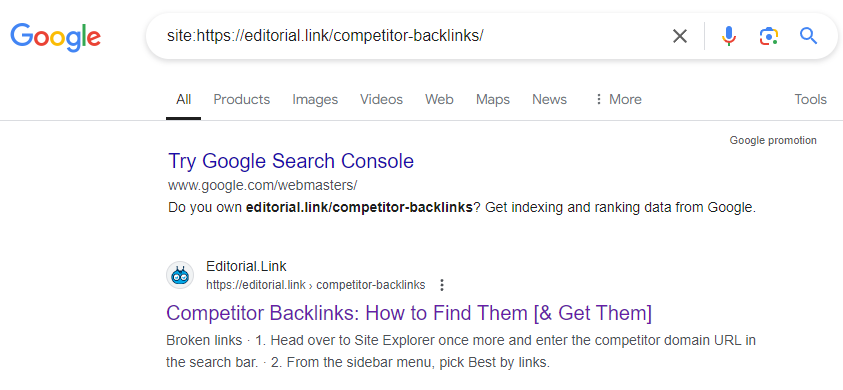
For more in-depth insights, use your SEO tools.
For example, BacklinkManager offers a free link evaluator tool that tells you if the page allows search engines to follow backlinks, if it has blocked crawling, and if it’s indexable and indexed.

Final Words
The link-building checklist outlines the key actions to take when embarking on the quest to enhance your backlink profile. By going methodically through the 16-step process, you reduce the risk that you omit an important part of the link-building campaign.
Having said that, designing comprehensive link-building strategies and orchestrating link-building campaigns still requires a fair bit of expertise, industry knowledge, and tons of energy, whether you use the checklist or not.
That’s the very reason why many marketing teams decide to outsource link-building to external providers. If you’re like them and you’d rather focus your attention on other high-impact projects, our team at Editorial.Link will be happy to help.
Don’t be shy and get in touch!

